Patients & visitors to the hospital can see these artworks in-person at the locations indicated belo
Hospitals can be stressful for families and support people. Art’s medicinal and restorative benefits for patients, visitors, and staff are more and more being recognized by research. Studies show that by improving and warming the hospital environment, art enhances the patient experience and speeds recovery. It also eases anxiety and stress for patients, families, and staff, and even provides moments of enjoyment and sharing.
Art can transform a clinical space into one of compassionate care, reflecting the care of the staff. It takes people away from themselves for a moment, offering a space for reflection or distraction, either directly or indirectly. It contributes to creating an atmosphere in which patients can feel safe and maintain a connection to the world outside the hospital.
The Kamloops Art Gallery guided the RIH Foundation through the process of developing a permanent collection of artworks by artists that represent diverse perspectives and approaches to art making and have been shown at the Kamloops Art Gallery. The location of each work in the Phil and Jennie Gaglardi Tower has been carefully chosen by factoring in the artwork’s size, the unit services it resides in, the visibility, and light. As you navigate this webpage, we hope you enjoy this virtual collection of art proudly made possible by the generous donors of the RIH Foundation.
2nd Floor Phil & Jennie Gaglardi Tower Art Locations.
On display outside of the Warner Rentals Respiratory Services Unit
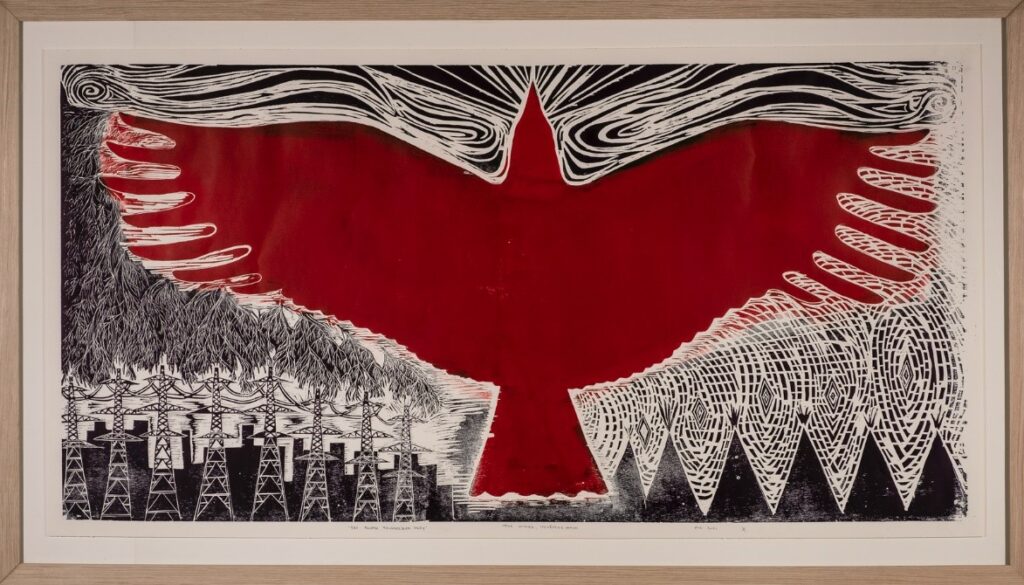
Tania Willard
Thunderbird Stories, 2021 – block print
Size: 39” high x 60” wide
Tania Willard
Tania Willard works within the shifting ideas around contemporary and traditional, often engaging with bodies of knowledge and skills that are conceptually linked to her interest in intersections between Indigenous and other cultures as a recognition of her mixed Secwépemc and settler heritage. Willard’s Thunderbird Stories draws on Indigenous storytelling, mythic animals, cryptozoology, as well as early wood engravings of people, animals, and lands made by European settlers in the “New World.” This print explores what constitutes one culture’s worldview and how that reality is then perceived by settler culture. Indigenous storytelling was historically perceived by colonizers and anthropologists as “myth” and by the church as superstitious, heathen, or pagan.
Indigenous cultures across the world share different oral histories of giant birds. Evidence in the fossil record of birds, Teratorns or Argentavis magnificens, discovered in Argentina, shows both raptors like eagles and a species more like the modern condor. The wingspan of Argentavis magnificens is estimated to be 28 feet. Other examples of giant birds included Haast’s eagle, an extinct giant species of eagle in Aotearoa/New Zealand. As with this eagle, an extinct species of giant flightless bird was recorded in Indigenous Maori culture. Scientists considered the Maori stories of this bird to be mythological until fossil records proved its existence.
The lower half of Willard’s print incorporates power lines, lightning fractals, and tipis with connecting designs. The iconography equates modern communication with Indigenous storytelling practices and asserts the relevance of Indigenous knowledges, rising above colonial oppression exerted upon Indigenous ways of knowing. The Thunderbird is synonymous with bringing thunder, storms, and lightning, and this work considers Indigenous embedded knowledge to be an electrifying source. The artist originally carved the block for this print in 2007 and then printed a series of three prints partially from the block, hand coloured them, and worked these newer versions back into the print. The entire block was printed in 2021, showing the full original print as carved.
An assistant professor in the Faculty of Creative and Critical Studies at UBCO in Syilx territories (Kelowna, BC Canada), Willard’s practice activates connection to land, culture, and family, centering art as an Indigenous resurgent act, though collaborative projects such as BUSH Gallery and support of language revitalization in Secwépemc communities. Her artistic and curatorial work includes Beat Nation: Art, Hip Hop and Aboriginal Culture at the Vancouver Art Gallery (2012-2014) and Exposure: Native Art and Political Ecology at the IAIA Museum of Contemporary Native Arts, Santa Fe (ongoing). Willard’s work is included in the collections of the Vancouver Art Gallery, Forge Projects, Kamloops Art Gallery, and the Anchorage Museum, among others. In 2016, she received the Hnatyshyn Foundation’s Award for Curatorial Excellence in Contemporary Art. In 2020, the Shadbolt Foundation awarded her their VIVA Award for outstanding achievement and commitment in her art practice, and in 2022 she was named a Forge Project Fellow for her land-based, community-engaged artistic practice.
On display inside the Warner Rentals Respiratory Services Unit
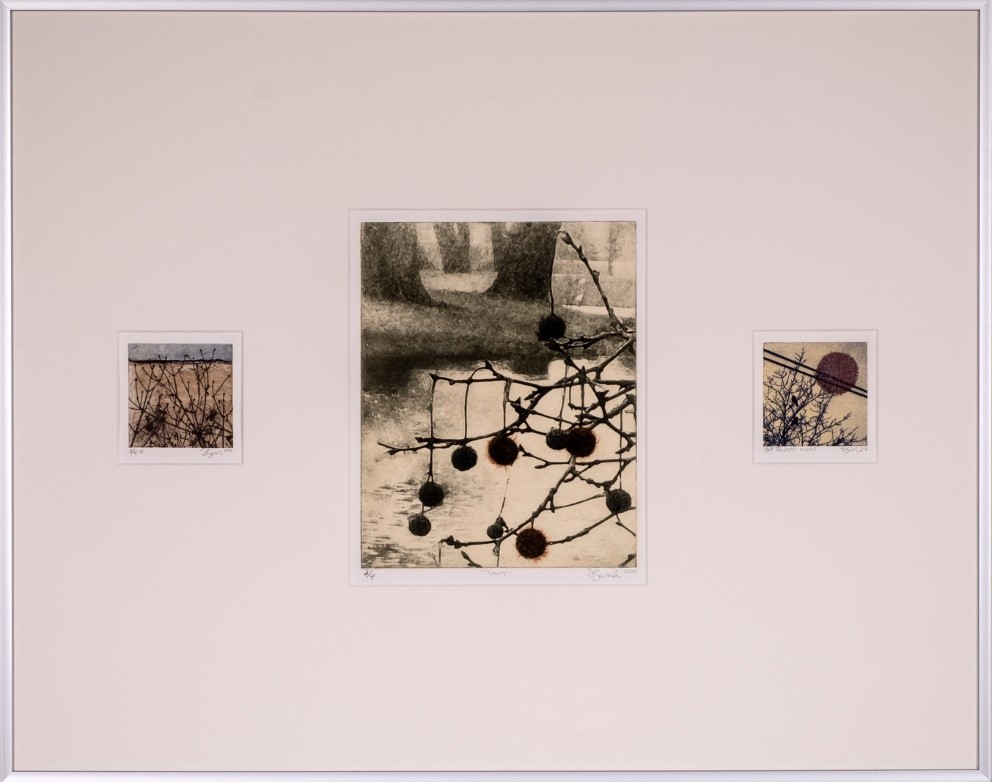
Jana Sasaki
Towy, 2012
Untitled, 2016
Blood Moon, 2016
Etchings with Chine-collé
Jana Sasaki
Jana Sasaki’s etchings use a traditional Japanese printmaking technique known by its French name Chine- collé. The technique allows the artist to print on a thin, delicate surface to achieve finer details. During the printing process, the lighter paper is bonded to a sturdier, often colour contrasting backing paper. With these prints, Sasaki has attempted to intuitively capture the Japanese aesthetic of Wabi-Sabi: simplicity, asymmetry, asperity, and flux of all things.
Jana Sasaki is a Vancouver-based artist who grew up in Merritt, BC. She identifies as Hapa, a person of mixed racial heritage with partial roots in Asian ancestry. Her work seeks a greater understanding of her heritage as a Japanese Canadian and the development of her identity. Representative of the resilient Japanese Canadian community in the Southern Interior and the fraught histories of internment that brought families from the coast to the Interior during the Second World War, Sasaki’s practice contributes important context to the Royal Inland Hospital Foundation’s collection and the diverse communities it serves.
Sasaki has exhibited her work nationally as well as in Japan, the United States, and the Netherlands. She is a recipient of the Vancouver Foundation Downtown Eastside (DTES) Small Arts Grant to explore Japanese Canadians and their connection to the DTES Oppenheimer District and Paueru-gai (Powell Street). Locally, Sasaki made collaborative artworks with members of the Japanese community in Kamloops as part of the Kamloops Museum & Archives exhibition Collective Memories: Japanese Canadian Reflections curated by Craig Willms and exhibited new work and work from the Kamloops Art Gallery’s collection in The Cube in 2021.
On display inside the waiting room of the Warner Rentals Respiratory Services Unit
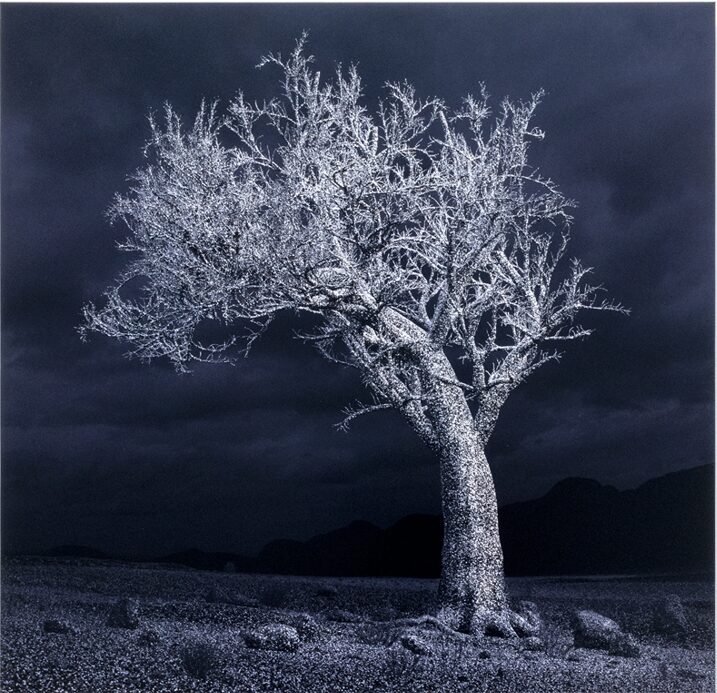
Kelly Richardson
Pillars of Dawn (II), 2015–2021
Dibond print
Edition 1/3 + 2AP
Kelly Richardson
Using digital technologies, Kelly Richardson creates hyper-real, sublime, and spectacular landscapes that communicate underlying unsettling narratives. Richardson’s practice is dedicated to a longstanding exploration of our relationship to nature and how this relates to climate change. Pillars of Dawn was produced both as a video work and as photographs, and presents uncanny images of illuminated, shimmering trees. In this work, each branch and the surrounding landscape is comprised of millions of individualized crystals, resembling diamonds. Upon closer observation, the images present a dystopic desert landscape where adverse environmental conditions have crystallized the terrain. One crystal in each of the Pillars of Dawn landscapes represents every species still alive today. In these fictitious landscapes, Richardson proposes a future reality where each species has been transformed into pure carbon. With diamonds being the most concentrated forms of pure carbon in the natural world as well as a signifier of wealth, Richardson asks us to consider what we value. This work was presented in her solo exhibition, Halcyon Fog, at the Kamloops Art Gallery in 2022.
Kelly Richardson is a Canadian artist based in Victoria, BC, where she is a Professor in Visual Arts at the University of Victoria. Richardson obtained her Bachelor of Fine Arts from the Ontario College of Art & Design, Toronto, Ontario, in 1997, a Master of Fine Arts from Nova Scotia College of Art and Design, Halifax, Nova Scotia, in 2003, and a Master of Fine Arts (with distinction) from Newcastle University, Newcastle, England in 2010. Her artwork has been widely acclaimed in North America, Asia, and Europe, and her video installations have been included in the Toronto International Film Festival and Sundance Film Festival. In addition to this collection, Richardson’s work has been acquired into significant museum collections across the United Kingdom, the United States, and Canada, from the Hirshhorn Museum and Sculpture Garden, Washington D.C.; SMoCA, Scottsdale, Arizona; and Albright-Knox Art Gallery, Buffalo, New York, to the National Gallery of Canada, Ottawa, Ontario; Art Gallery of Ontario, Toronto; and Musée d’art contemporain de Montréal.
On display inside the Parkview Child & Adolescent Mental Health Unit
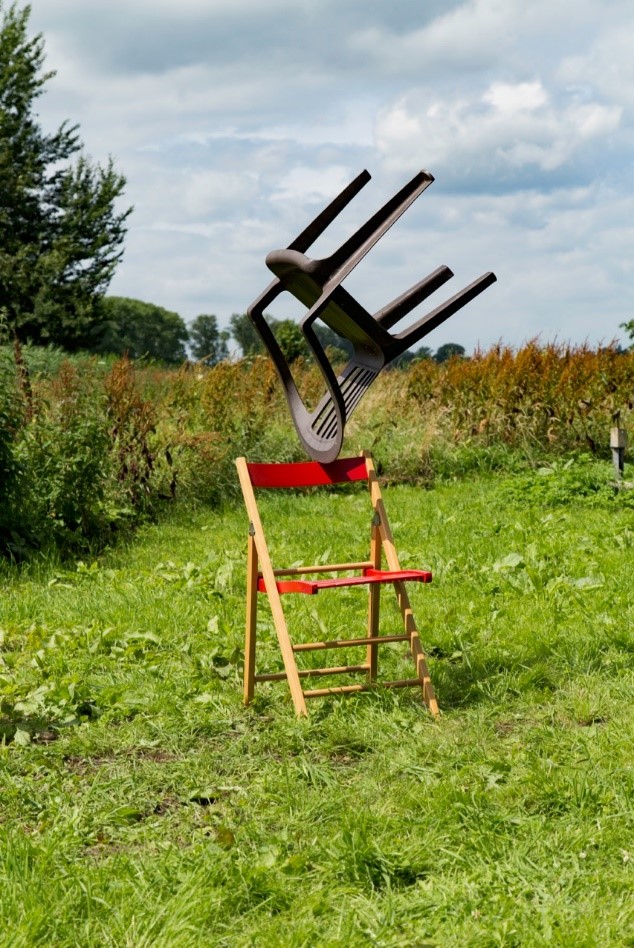
Samuel Roy-Bois
The Origin of the Family, Private Property and the State (two chairs), 2016
Chromogenic print
Samuel Roy-Bois
This photograph by Samuel Roy-Bois is part of The Origin of the Family, Private Property and the State series which explores the relationship between photography, sculpture, and everyday objects. The series, created between 2016 and 2019, presents a group of photographic sculptures made from things Roy-Bois found on a property in Germany during an artist residency at Künstlerhaus Worpswede. Realized with the help of his children, who balanced the found objects and then quickly disappeared from the camera lens, the series presents momentary, precariously composed sculptures that exist only long enough to be documented. Suspended for the brief opening of the camera shutter, the sculptures are only experienced by the viewer through the photographs. Roy-Bois’ unconventional use of sculpture and photography subverts our expectations of both mediums.
Samuel Roy Bois exhibited this series and a new body of work Presences at the Kamloops Art Gallery in 2019. The exhibition then toured to the Esker Foundation in Calgary, Alberta in 2020 and The Origin of the Family series was exhibited at Musée d’art de Joliette, Québec, in partnership with the Kamloops Art Gallery in 2022. A joint publication of this exhibition was released by the Kamloops Art Gallery and Esker Foundation in 2022. The hand-bound publication uses discontinued book cloths to create 26 unique book covers, a colourful nod to the repurposing of everyday items as explored in Roy-Bois’ work.
Samuel Roy-Bois is Assistant Professor of Sculpture in the Faculty of Creative and Critical Studies at the University of British Columbia Okanagan Campus and heads an interdisciplinary lab for creative exchange, The Research Studio for Spaces and Things. Originally from Québec City, Québec, Roy-Bois obtained his Bachelor of Fine Arts from Université Laval, Québec City in 1996 and a Master’s Degree in Fine Arts from Concordia University, Montréal, Québec in 2001. His work has been shown across Canada and internationally. In 2021, Roy-Bois received the VIVA award, granted to mid-career artists, chosen for outstanding achievement and commitment by the Jack and Doris Shadbolt Foundation for the Visual Arts, in Vancouver, BC. In addition to the having work in this collection, Roy-Bois’ work is in the collections of the Musée d’art contemporain de Montréal, Montréal, Québec; SFU Art Galleries, Vancouver, BC; Collection d’oeuvres d’art de l’Université Laval, Laval, Québec City Québec; Westbank Corporation, Vancouver, BC; City of North Vancouver, and Kamloops Art Gallery.
3rd Floor Phil & Jennie Gaglardi Tower Art Locations
On display inside the Evening Auxiliary to the RIH Obstetrical Services Unit
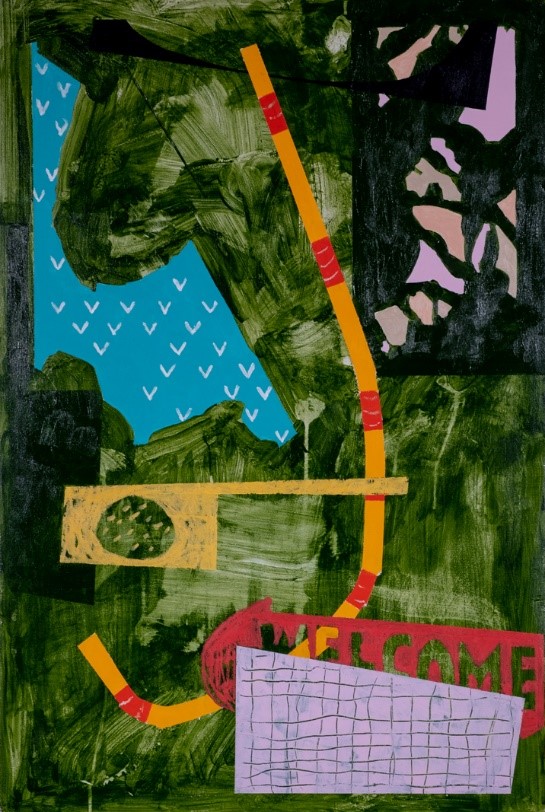
Robin Hodgson
Welcome, 2019
Acrylic, latex, oil stick on birch panel
Robin Hodgson
Robin Hodgson creates autoethnographic work that reflects his experience living as C5/C6 tetraplegic. Working from a wheelchair with limited movement in his hands and arms, his working process involves the use of various adaptive tools that aid him in his studio practice. The development and creation of these adaptive tools began shortly after his injury as a way for him to simply hold a paintbrush and has continued throughout his career as he explores new painting mediums and processes. Hodgson’s painting Welcome celebrates the diverse journeys of fertility and the joys of bringing new life into this world.
In 2022 the Kamloops Art Gallery presented the exhibition Sailing Pretty Close to the Wind, a collection of Hodgson’s paintings that explore the psychological and emotional nature of post-able-bodied life. The exhibition title plays on a common aphorism recalling the story of Icarus flying too close to the sun and refers to actions on the edge of acceptable behaviour. In the artist’s case, living on the edge as a young person resulted in a life-long disability. Although Hodgson has lost his hand, finger, and tricep muscle function, his biceps and limited wrist flexion allow him enough mobility to continue drawing and painting from his wheelchair with the set of adaptive tools he has created, and the help of his studio assistants.
Currently Hodgson is pursuing his MFA at UBC Okanagan. In his thesis he is developing a body of paintings using a new device he has built that removes his hand from the painting process. By placing canvases flat on the ground his device relies on the movement of his wheelchair to dictate the movement of the paintbrush, resulting in a much looser approach to his work. By acquiring Hodgson’s work for its collection, the Royal Inland Hospital Foundation is supporting a Kamloops-based artist, and sharing a personal story of resiliency from someone who has much lived experience at the hospital during seminal times in his life.
Robin Hodgson earned a Bachelor of Fine Arts degree from Thompson Rivers University, Kamloops, BC, and is currently completing his Masters of Fine Arts at University of British Columbia Okanagan. Hodgson has co-created two not-for-profit studio and exhibition spaces in Kamloops, Padlock Studios (2014-2017) and REpublic Gallery (2018-2021). These gathering spaces provided studios and exhibition opportunities for emerging artists and venues to host arts-related community events. In 2019, Hodgson received the Kamloops Mayor’s Award for the Arts, as Emerging Artist of the Year, and in 2023 he was the recipient of the Tanabe Prize as British Columbia’s emerging artist of the year, in the field of painting.
On display inside the Evening Auxiliary to the RIH Obstetrical Services Unit
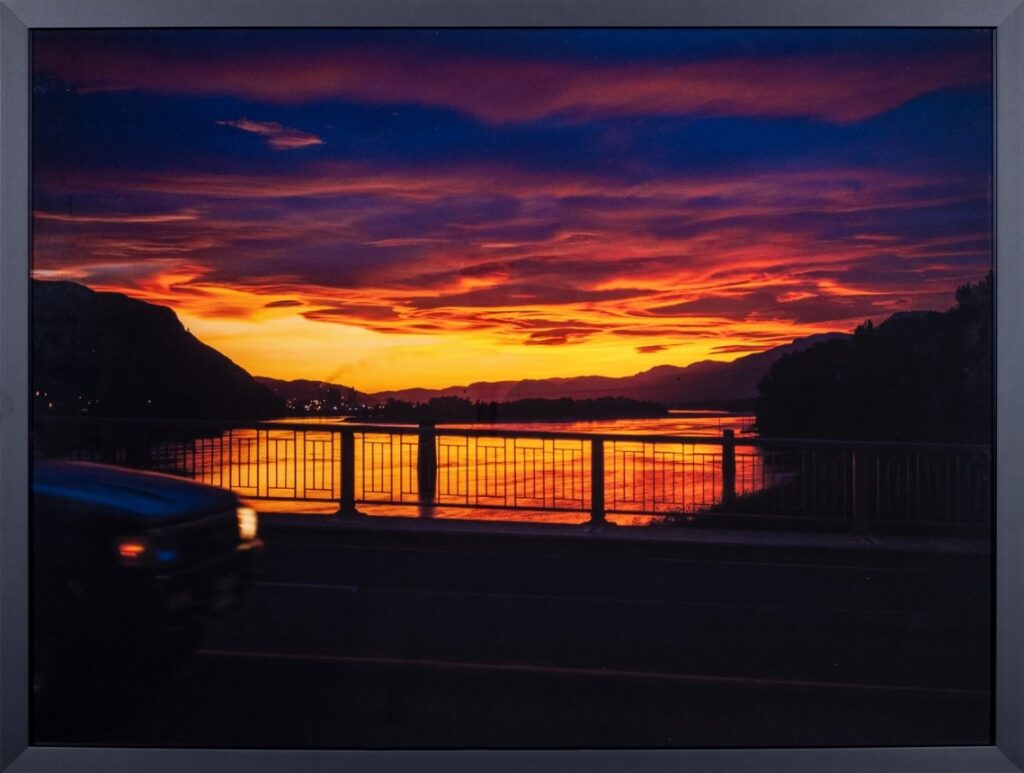
Frank Luca
Motion Makes Me Last, 2021
Archival photo rag cotton paper
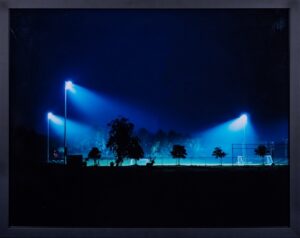
Frank Luca
Nil-Nil-Draw, 2021
Archival photo rag cotton paper
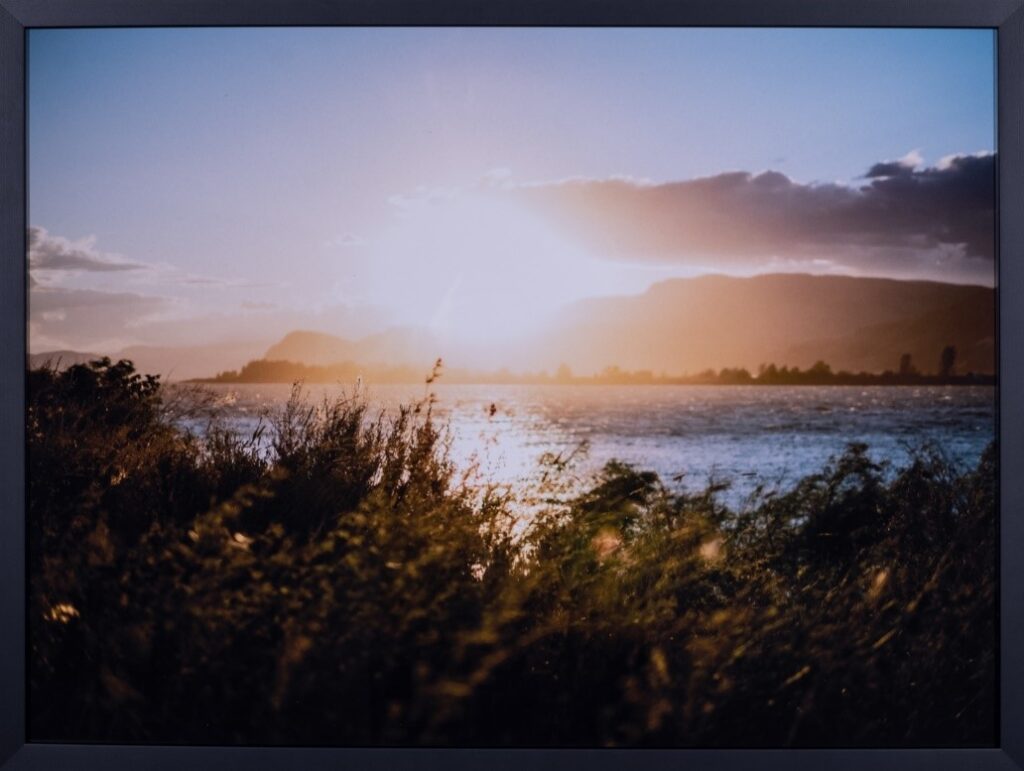
Frank Luca
Shimmer, 2021
Archival photo rag cotton paper
Frank Luca
This selection of photographs from Frank Luca’s Memories of Light series celebrates the beauty and strangeness of ordinary or unassuming places when illuminated with atmospheric light. Within this series, Luca documents ethereal landscape compositions using only available light – natural or artificial – to evoke a sense of nostalgia.
Frank Luca is a photographer and graphic designer living and working in Kamloops, BC. He graduated from the Digital Art and Design program at Thompson Rivers University, Kamloops, and has since started his own freelance company: Frank Luca Creative. Luca has frequently collaborated with Kamloops Art Gallery, Kamloops Museum & Archives, Tourism Kamloops, and a number of local businesses. His designs are recognizable for their combination of modernist influences and minimalist appeal. Luca’s photographic work has been featured in Olympus Passion, an inspirational photography magazine as well as in publications, Circles and Small Victories, which showcase the work of up-and-coming photographers and are published by Booooooom, an internationally acclaimed art blog that has shined light on many talented emerging artists and designers.
On display inside the Evening Auxiliary to the RIH Obstetrical Services Unit
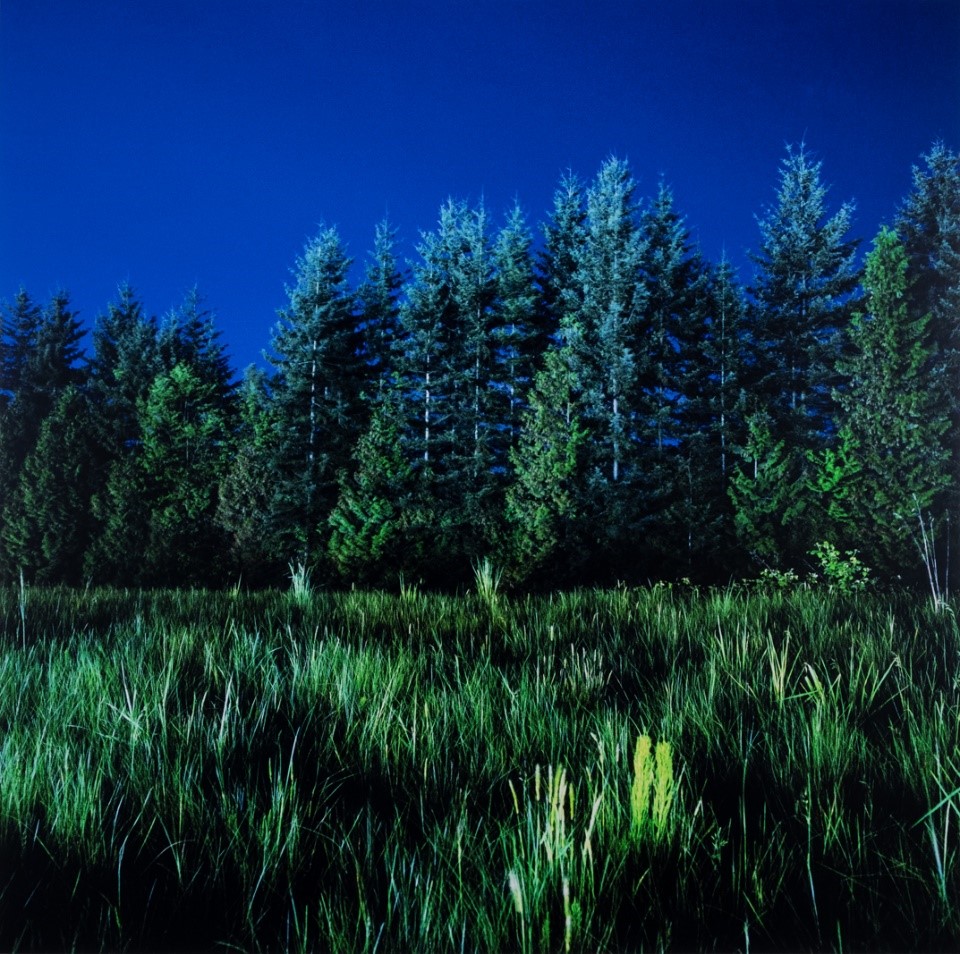
Scott Massey
Crepuscule #14 (Hwy #1 at McCallum Rd, Automall 1), 2003–2006
Archival inkjet prints on aluminum, UV face laminate, polished edges
Edition 1/6
On display inside the Evening Auxiliary to the RIH Obstetrical Services Unit
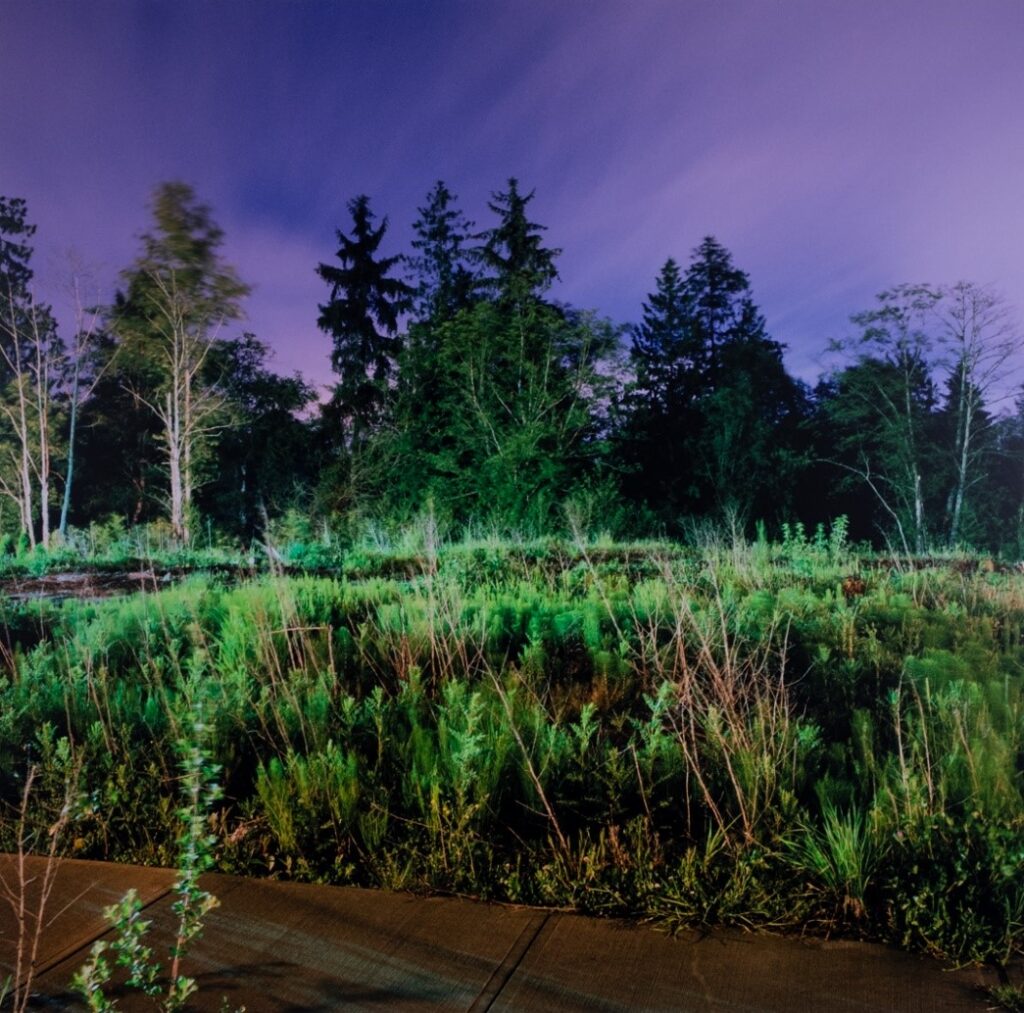
Scott Massey
Crepuscule #13 (170 St at 86A Ave), 2003–2006
archival inkjet prints on aluminum, UV face laminate, polished edges
Edition 2/6
Scott Massey
Scott Massey’s work explores the confluence of art and science by accentuating and amplifying natural phenomena through artificial means or slight manipulations. Light as a medium and image-making apparatus are fundamental aspects of his practice.
These photographs are part of a larger collection of work, Crepuscule, created between 2003 and 2006. This series of photographs observe the power of artificial light along the divisions between suburban development and untamed nature, where the built environment borders natural landscapes. Massey captures the tension of these spaces illuminated only by ambient artificial light cast by various sources always outside of the frame, such as streetlamps, security lights, parking lot lights, as well as the turbid twilight effect of pervasive urban lighting reflected down from clouds overhead. In this peculiar lighting, the landscapes appear unsettlingly strange, yet familiar. The electric light spreading out into the landscape becomes a harbinger of future development, an acknowledgement that the views captured within the camera’s frame will inevitably be infiltrated by development.
Minor Incidents is a body of work documenting ephemeral interventions performed in light industrial landscapes. Only one element within a given scene is ever manipulated; everything else is left as found. The subtle modifications take their cue from activities undertaken by civic maintenance and engineering workers and play on notions of artistic maintenance within the built environment. The small and playful interventions profoundly change the reading of a scene or our experience of it. Massey’s image-based artworks confound normal methodologies of the media by inverting processes or corrupting apparatus, and his sculptural works often employ a performative or durational element that further activates the work.
Massey holds a Bachelor of Fine Arts in photography from the Emily Carr University of Art + Design, and begins his Master of Fine Arts at the University of British Columbia in 2024. He has participated in artist residencies at the Klondike Institute of Art and Culture (Dawson City, YT); the Banff Centre for Arts and Creativity (Banff, AB); Dazibao/PRIM (Montréal, QC); and with Lumen Collective (Atina, Italy). Solo exhibitions of Massey’s work include A Marker to Measure Drift, Kamloops Art Gallery; Light Adjustments, Dazibao (Montréal, QC); Movement Without Moving, VU Photo (Quebec City, QC); Let’s Reach c Together, Charles H. Scott Gallery (Vancouver, BC); Topologies and Limits, CSA Space (Vancouver, BC); and Swan Song, Luminato Festival (Toronto, ON). His work has also been included in group exhibitions in Canada and abroad at Kunsthal Charlottenborg (Denmark); Contemporary Art Gallery (Vancouver, BC); the Columbus College of Art & Design (Ohio); and CONTACT Photography Festival (Toronto, ON).
5th Floor Phil & Jennie Gaglardi Tower Art Locations
On display inside the Judy & Kevin Chaben Staff Wellness Area
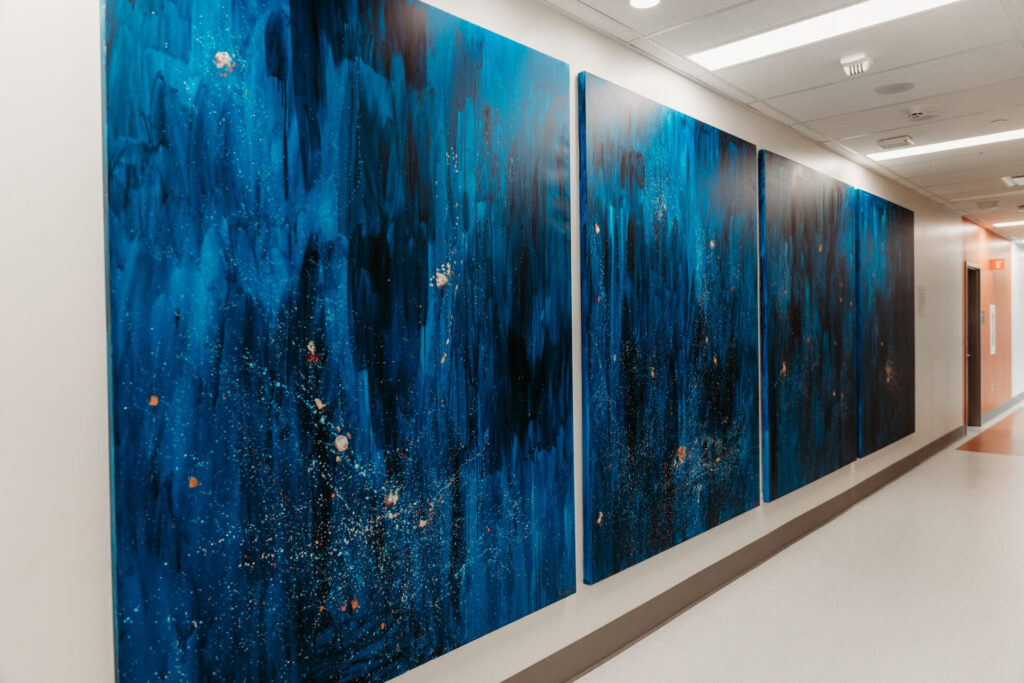
Tricia Sellmer
And I heard him whisper “it is only in the darkness that we see the stars”
#1, #2, #3, #4
Tricia Sellmer
Over the years I have spent hours looking up, way, way up, at the night sky. I am struck by the vastness of the darkened space that holds pixels of light that flash on, stay, and after time gradually fade away when the morning star arrives. At times the pixels dance. I wonder, marvel, question the Prussian Blue expanse that holds the lights within the Milky Way. I understand we are but a minuscule speck, in this great universe that swirls in the cosmos.
The inspiration behind these four paintings, And I heard him whisper ”it is only in the darkness that we see the stars” #1,#2,#3,#4, grew from hours spent quietly stargazing. The reference points reflect in-depth research of constellations maps, images captured by both the Hubble and the James Webb telescopes, and musical selections. Listening to Henrik Goldschmidt play Ennio Morricone’s Gabriel’s Oboe with the Faroe Islands Philharmonic Orchestra, I could imagine floating, dancing, tagging the stars, moving from one constellation to another. I included gold leaf but did not glue the gold leaf onto the canvas but rather applied it with wax, suggesting the fragility of the universe and creation. There is a speck of gold on the first canvas of And I heard him whisper ”it is only in the darkness that we see the stars” that can only be viewed from a certain vantage point. This speck of gold will flash on and off depending on the viewers’ stance and exemplifies someone very important to me and the experiences we shared… dancing among the stars.
Tricia Sellmer is a multi-layered, multi-medium, contemporary, Canadian visual artist working primarily within the parameters of painting and drawing. For the past twenty years she has concentrated on making the invisible visible and finding the extraordinary in the ordinary. Her paintings and drawings explore the inner and hidden workings of a garden, the sensuousness and shifting patterns within a landscape and the organic textural abstractions of surfaces. From time to time, she will step away from the easel and use text and mixed media to convey her thoughts, ideas and narrative. As an independent working artist, she also writes, lectures and curates projects and exhibitions. She holds four degrees from three universities and has participated in numerous residencies. Her works hang in collections throughout North America, Europe, Mexico and South Africa.
On display inside the Judy & Kevin Chaben Staff Wellness Area
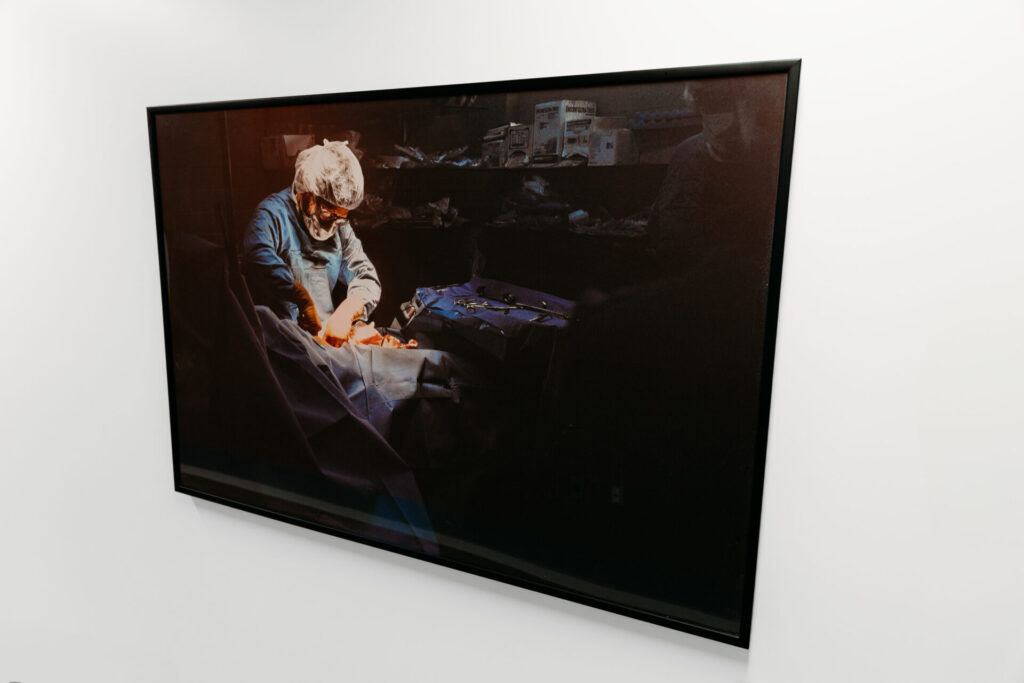
Tricia Sellmer
Surgeon and The Uterus, 2002
Tricia Sellmer
In 2002, Tricia Sellmer had the privilege of joining and documenting the work of Medicos in Action Group, a volunteer medical team that travelled to Guatemala on an annual basis. Part of the documentation included observing surgery performed by Dr. Gary Kinney. This image catches the reflection of a prolapsed uterus in Dr. Kinney’s glasses. Apparently, the patient had travelled three days to reach the medical clinic and had suffered the prolapsed uterus for many years.
Making the invisible visible and finding the extraordinary in the ordinary. Her paintings and drawings explore the inner and hidden workings of a garden, the sensuousness and shifting patterns within a landscape and the organic textural abstractions of surfaces. From time to time, she will step away from the easel and use text and mixed media to convey her thoughts, ideas and narrative. As an independent working artist, she also writes, lectures and curates projects and exhibitions. She holds four degrees from three universities and has participated in numerous residencies. Her works hang in collections throughout North America, Europe, Mexico and South Africa.
6th Floor Phil & Jennie Gaglardi Tower Art Location
On display outside the entrance to the Kelson Group Mental Health and Substance Use Unit

Scott Massey
Two Yellow Lines from Minor Incidents series, 2004–2006
Archival inkjet prints on Alucore, UV face laminate, custom colour wood frame
Edition 2/6 + 1 AP
Scott Massey
Minor Incidents is a body of work documenting ephemeral interventions performed in light industrial landscapes. Only one element within a given scene was manipulated; everything else is left as found. The subtle modifications take their cue from activities undertaken by civic maintenance and engineering workers and play on notions of artistic maintenance within the built environment. The small and playful interventions profoundly change the reading of a scene or our experience of it. Scott Massey’s image-based artworks confound normal methodologies of the media by inverting processes or corrupting the apparatus, and his sculptural works often employ a performative or durational element that further activates the work.
Scott Massey holds a Bachelor of Fine Arts in photography from the Emily Carr University of Art + Design, Vancouver, BC. He has participated in artist residencies at the Klondike Institute of Art and Culture, Dawson City, Yukon; the Banff Centre for Arts and Creativity, Banff, Alberta; Dazibao/PRIM, Montréal, Québec; and with Lumen Collective, Atina, Italy. Solo exhibitions of Massey’s work include A Marker to Measure Drift, Kamloops Art Gallery, 2021; Light Adjustments, Dazibao, Montréal, Québec; The Day Breaks, Gallery 44 Centre for Contemporary Photography, Toronto, Ontario; Let’s Reach c Together, Charles H. Scott Gallery, Vancouver, BC; Topologies and Limits, CSA Space, Vancouver, BC; and Swan Song, Luminato Box, Toronto, Ontario. His work has also been included in group exhibitions in Canada and abroad at Kunsthal Charlottenborg, Copenhagen, Denmark; Contemporary Art Gallery, Vancouver, BC; the Columbus College of Art & Design, Ohio; and CONTACT Photography Festival, Toronto, Ontario.
On display outside the entrance to the Kelson Group Mental Health and Substance Use Unit

Frank Luca
Vanishing Point, 2020
archival photo rag cotton paper
Frank Luca
This selection of photographs from Frank Luca’s Memories of Light series celebrates the beauty and strangeness of ordinary or unassuming places when illuminated with atmospheric light. Within this series, Luca documents ethereal landscape compositions using only available light – natural or artificial – to evoke a sense of nostalgia.
Frank Luca is a photographer and graphic designer living and working in Kamloops, BC. He graduated from the Digital Art and Design program at Thompson Rivers University, Kamloops, and has since started his own freelance company: Frank Luca Creative. Luca has frequently collaborated with Kamloops Art Gallery, Kamloops Museum & Archives, Tourism Kamloops, and a number of local businesses. His designs are recognizable for their combination of modernist influences and minimalist appeal. Luca’s photographic work has been featured in Olympus Passion, an inspirational photography magazine as well as in publications, Circles and Small Victories, which showcase the work of up-and-coming photographers and are published by Booooooom, an internationally acclaimed art blog that has shined light on many talented emerging artists and designers.
7th Floor Phil & Jennie Gaglardi Tower Art Locations
On display in the waiting room of the Connors Drilling Rehabilitation & Medical Unit
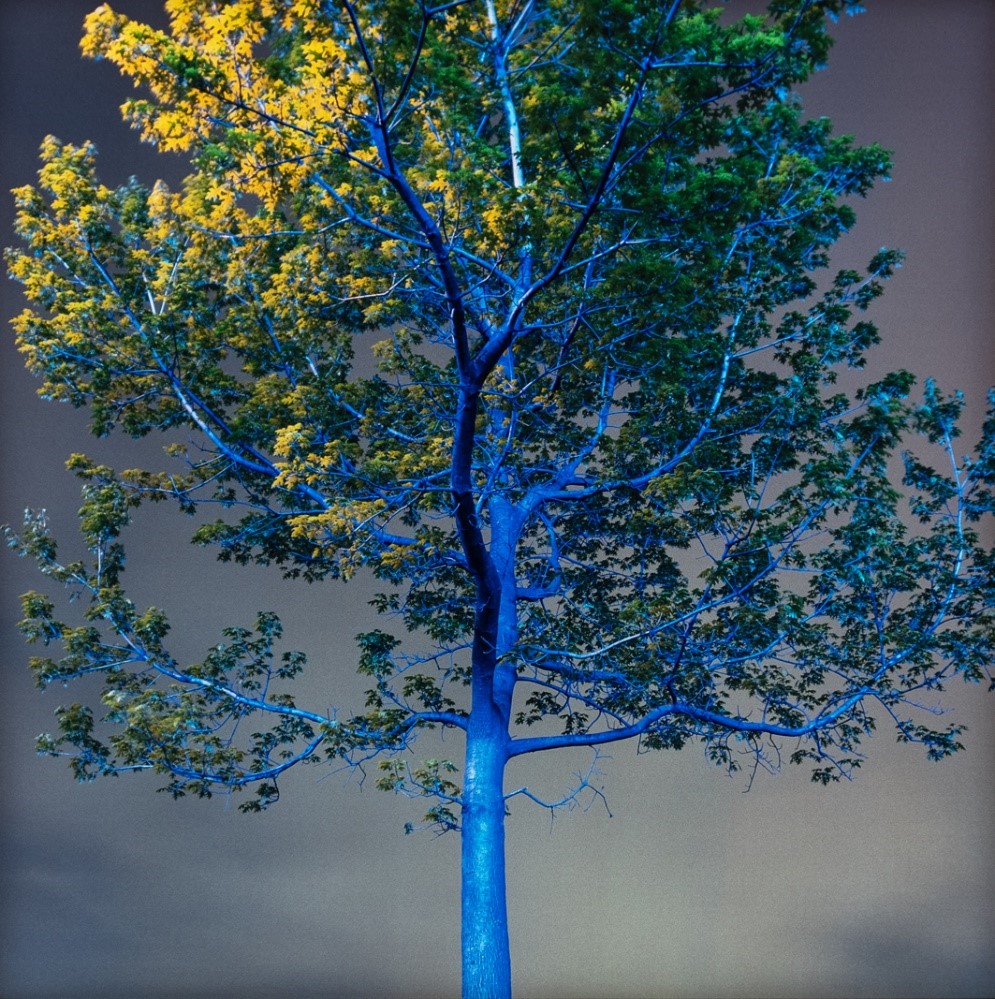
Scott Massey
Illuminated Tree, 2002
Archival inkjet print on aluminum, UV face laminate, polished edges
Edition 1/3
Scott Massey: See description above.
On display inside of the Connors Drilling Rehabilitation & Medical Unit
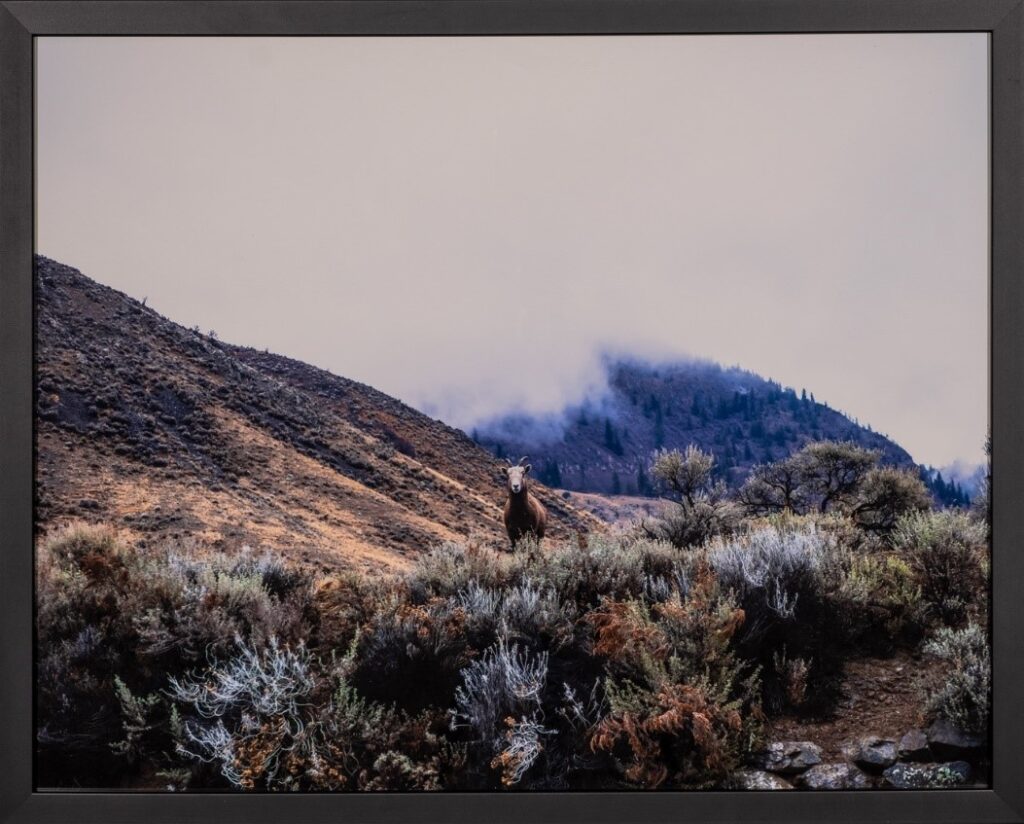
Frank Luca
Big Horn Watching, 2020
Archival photo rag cotton paper
Frank Luca: See description above.
On display inside of the Connors Drilling Rehabilitation & Medical Unit
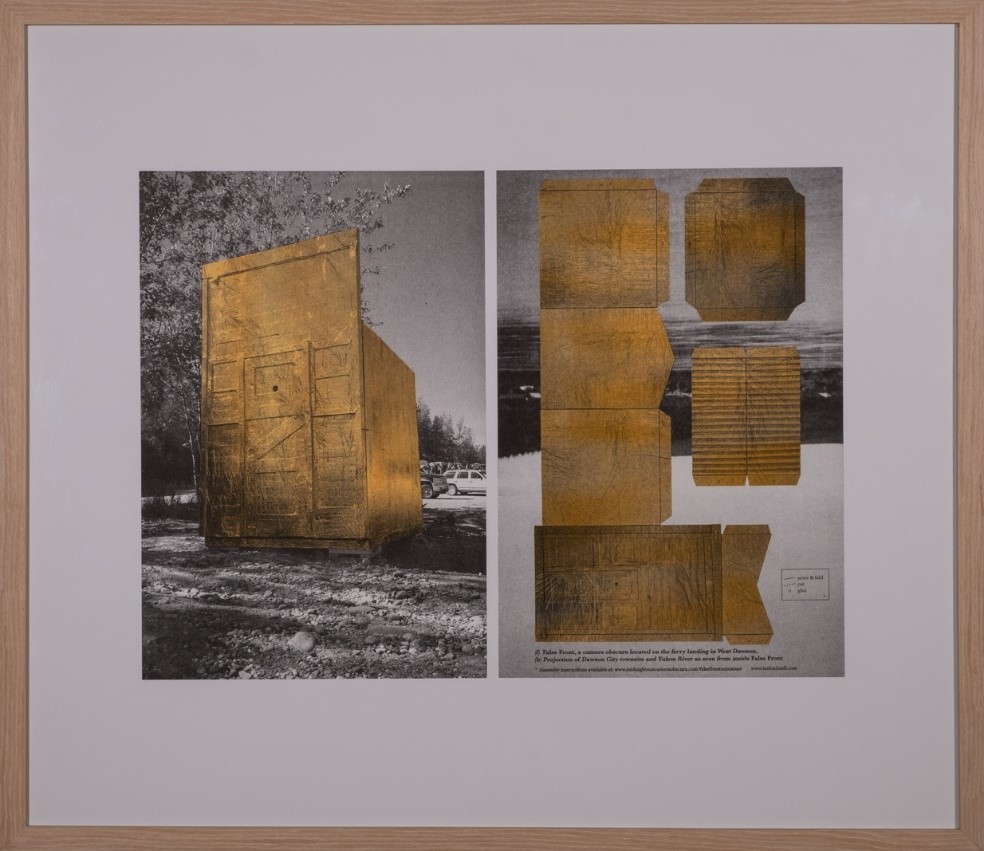
Lea Bucknell
False Front Poster, 2017
Risograph print
Lea Bucknell
False Front was an interactive sculpture constructed as part of the Midnight Sun Camera Obscura Festival held in Dawson City, Yukon, during the 2015 summer solstice where the protracted hours of daylight allowed for optimal viewing of the cameras obscura installed throughout the townsite. Lea Bucknell created False Front to speak to both the symbolic heritage of Dawson City and the present-day town site. Drawing upon curator, writer and critic Lucy Lippard’s claim, “All places exist between the inside and outside views of them…” False Front called attention to the iconic Gold Rush history and lore of Dawson City as well as provided an opportunity to contemplate the town as it is today. The form of False Front borrowed from vernacular Gold Rush-era architecture that typifies much of Dawson City. The structure’s flashy gold cladding gave way to a more subdued interior by way of the large 6 x 10 foot false front facade that hinged opened to provide audience members access to the interior.
Inside, viewers saw an inverted projection of the Yukon River, the townsite, and its surrounding landscape. The original sculpture was purchased by a private resident in Dawson City. When the Kamloops Art Gallery presented the exhibition Midnight Sun Camera Obscura in 2016, a replica of the False Front door was shown alongside images of the original sculpture. This two-sided risograph poster was created for subsequent travelling exhibitions of the Midnight Sun Camera Obscura Project shown at the Klondike Art Gallery, Whitehorse, Yukon; the University of Lethbridge Art Gallery, Lethbridge, Alberta; and McMaster Art Gallery, Hamilton, Ontario and it is now part of the Royal Inland Hospital Foundation’s collection.
Lea Bucknell is a Kamloops-based artist and educator who works as a studio technician and instructor in the Visual Arts program at Thompson Rivers University. She obtained her Master of Fine Arts degree from Western University, London, Ontario, and has participated in residencies at the Banff Centre for Arts and Creativity, Banff, Alberta; the Vermont Studio Center, Johnson, Vermont; and the Klondike Institute of Art and Culture, Dawson City, Yukon. Bucknell has received grants from the BC Arts Council and Canada Council for the Arts, as well as a number of other scholarships and awards.
On display inside of the Connors Drilling Rehabilitation & Medical Unit
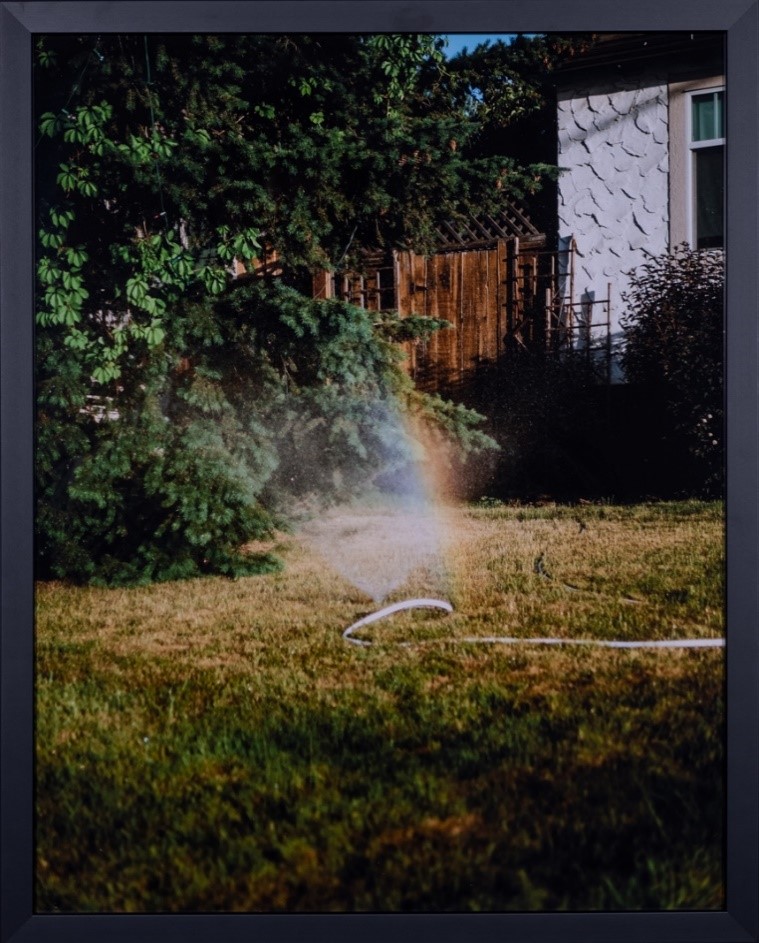
Frank Luca
Light Sprinkles, 2021
Archival photo rag cotton paper
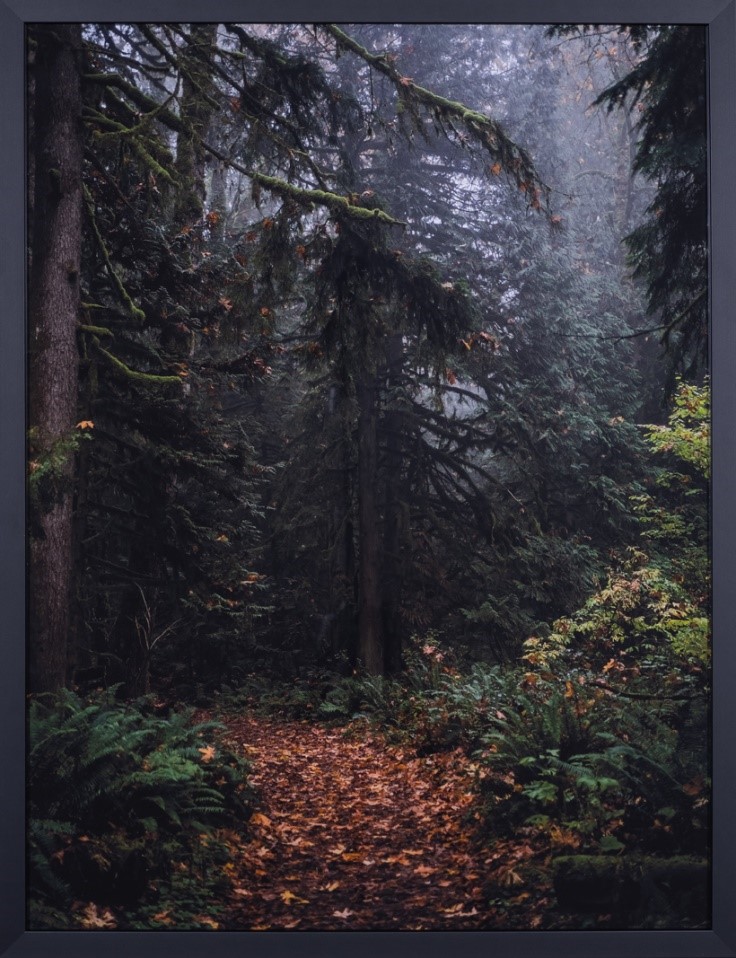
Frank Luca
In the Woods, 2021
Archival photo rag cotton paper
Frank Luca: See description above.
8th Floor Phil & Jennie Gaglardi Tower Art Locations
On display inside the Neurosciences & The Stollery Charitable Foundation Trauma Unit
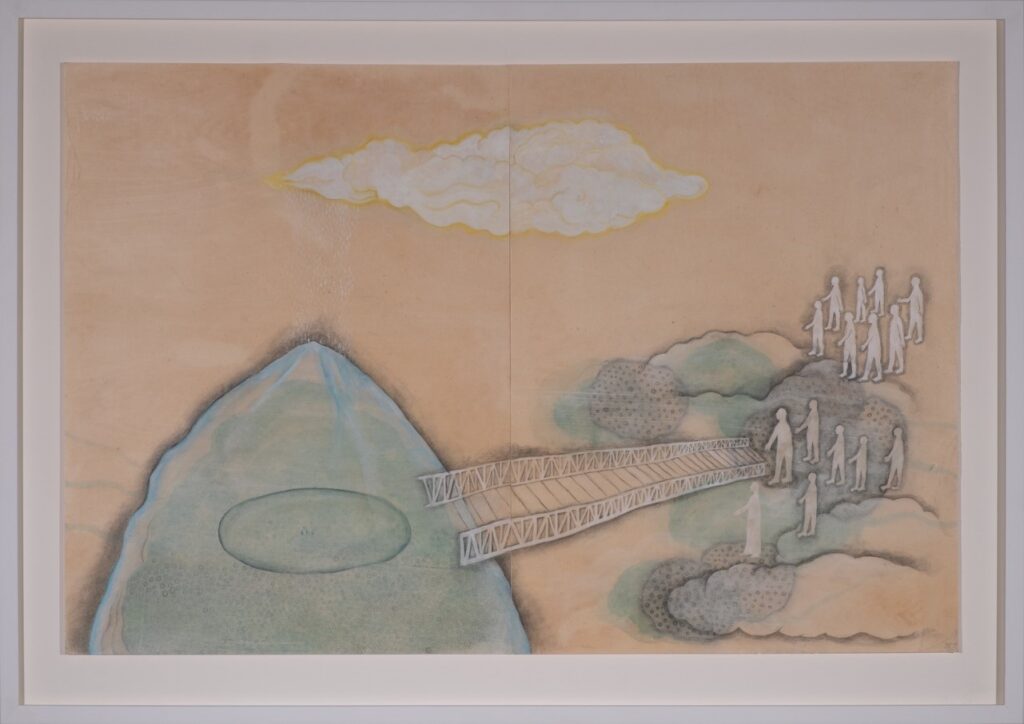
Tomoyo Ihaya
Pilgrimage, 2015
Mixed media on Japanese paper laminated on wooden panel
Tomoyo Ihaya
Tomoyo Ihaya’s artistic practice consists of detailed works of paper, mixed-media installations, and video works that are influenced by her experiences abroad, most notably in India. Since 2005, Ihaya has made numerous extended trips to the northern Indian regions of Ladakh and Dharamsala and has spent an extensive amount of time with Tibetan communities in exile. Her personal practice of Tibetan Buddhism, particularly incorporating the Tibetan gesture of ninjye, which extends compassion and recognition to those affected by oppression, is visible in her sensitive approach and longstanding engagement with the lives and struggles of refugees and persecuted minorities, responding to their hardships and their stories. Pilgrimage is part of Drawings on Water (Building Bridges), a series created between 2015 and 2016. Reoccurring motifs of water, vessels, eyes, and lanterns act as poetic metaphors in her work. As seen in Pilgrimage, the bridge is a symbol of hope and can be understood as the hope of a new life somewhere else or the hope of coming back to one’s homeland.
Born and raised in Tsu City, Mie, Japan, Tomoyo Ihaya has been a resident of Canada since 2000. She currently lives and works in Vancouver, BC. Ihaya received a Bachelor of Arts from Rikkyo University, Japan, and studied studio arts at universities across Canada, obtaining her Master of Fine Arts in printmaking from the University of Alberta, Edmonton, Alberta, in 2002. Ihaya has exhibited her work in solo and group exhibitions across Canada and in the United States, Australia, Japan, and Europe and has produced artwork through international artist-in-residency programs in India, Mexico, Thailand, the United States, and Canada. In 2021, Ihaya exhibited work in Whose Stories? at the Kamloops Art Gallery, an exhibition curated by Makiko Hara.
On display inside the Neurosciences & The Stollery Charitable Foundation Trauma Unit
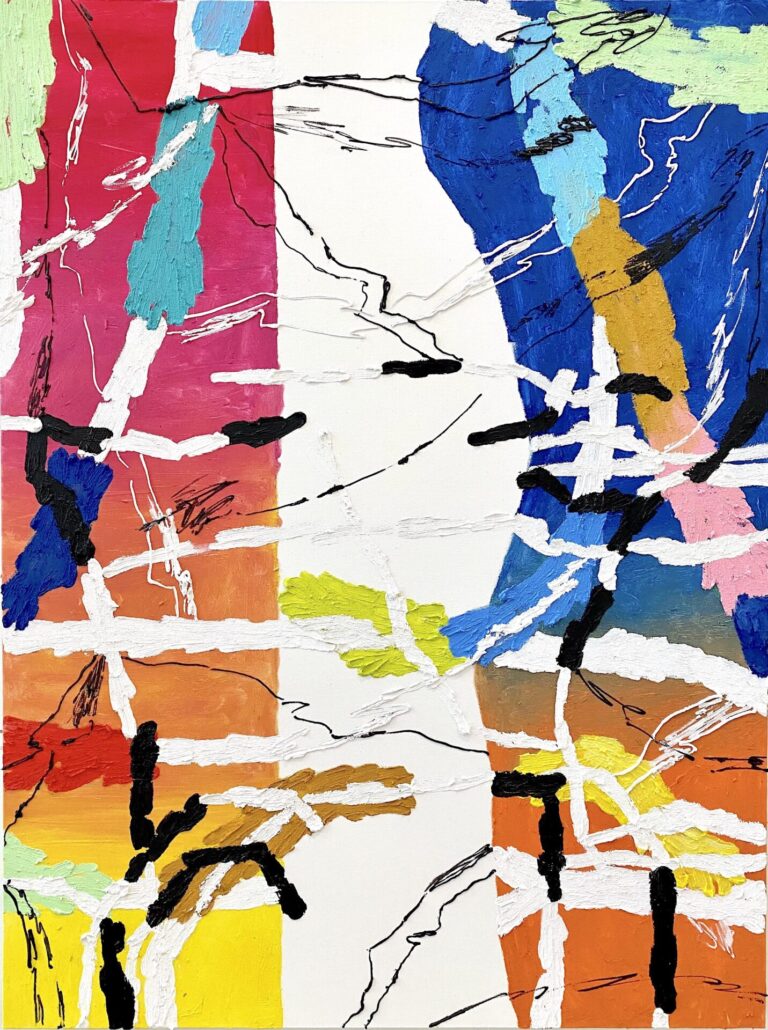
Russna Kaur
An edge – the tangled path, 2022
Acrylic and sawdust on canvas
Russna Kaur
Russna Kaur (b. 1991, Toronto, Ontario) is a painter currently living and working in Vancouver, British Columbia. Kaur completed a Bachelor of Arts at the University of Waterloo (2013) and a Master of Fine Arts at Emily Carr University of Art + Design (2019). Kaur is the recipient of the Takao Tanabe Painting Prize (2020) and the IDEA Art Award (2020).
She has exhibited works nationally at institutions including the Kamloops Art Gallery (2021), Remai Modern in Saskatoon, SK (2023), and internationally at Galerie Isa in Mumbai, IN (2023). Upcoming exhibitions include those at the Audain Art Museum (2024), Vancouver Art Gallery (2024), Kenderdine Art Gallery at the University of Saskatchewan (2025), and the Art Gallery of Burlington (2025).
Kaur has been an artist-in-residence at the Burrard Arts Foundation (2020) in Vancouver, the Centrum Emerging Artist Residency (2020) in Port Townsend, Washington and an Independent Artist Residency in Los Angeles, California (2024).
She was commissioned to create public artwork for the Translink Art Columns in the City of Richmond, BC (2018), Boren Banner Series at the Frye Art Museum, Seattle, WA (2021), Peel Art Gallery, Museum and Archives in Brampton, ON (2022) and Square Nine Developments in Burnaby, BC (2026).
Kaur’s work is held in numerous private, corporate and institutional collections including the TD Bank Collection, RBC Art Collection, Audain Art Museum, the Vancouver Art Gallery, the Surrey Art Gallery, and the Gordon Smith Gallery of Canadian Art.”
On display inside the Neurosciences & The Stollery Charitable Foundation Trauma Unit
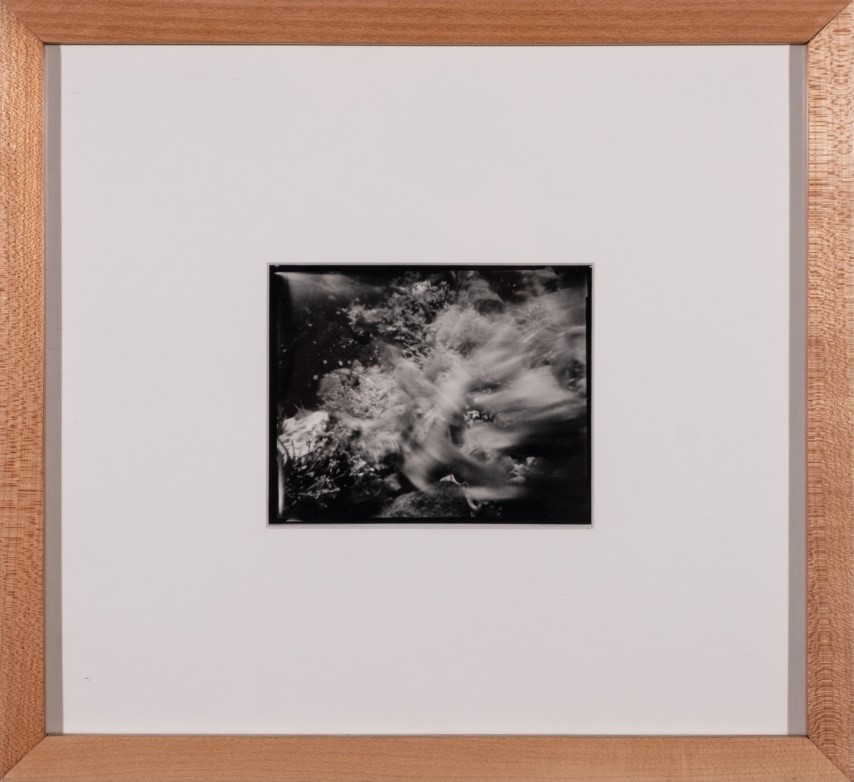
Donald Lawrence
Rockweed, Sober Island, Nova Scotia, 2002
Underwater pinhole photographs, from kayak; gelatin silver contact prints
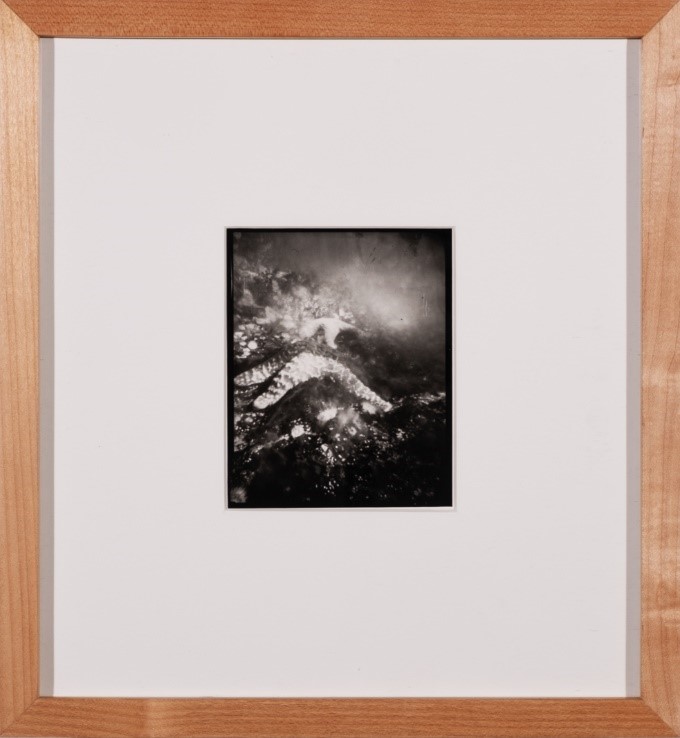
Donald Lawrence
Starfish in Tidal Surge, Stephenson Point, Nanaimo, 1998
Underwater pinhole photographs, from kayak; gelatin silver contact prints
Donald Lawrence
These contact prints, made directly from 4 x 5-inch film negatives, were created by elaborate underwater pinhole cameras constructed by artist Donald Lawrence for the Underwater Pinhole Photography Project, an exploration he began in 1997. A pinhole camera is an enclosed box that allows light, entering through a pinhole-sized opening, to expose the image on film placed inside the camera. Because the pinhole camera does not use a lens and requires long exposure times, the images have a soft resolution and captured movements appear blurry. By taking images of the aquatic life beneath the tide, either from his custom kayak or the shore, Lawrence combines his interests in sea kayaking and coastal environments with a long-standing interest in rudimentary image-making technologies. Indicative of the way that each of Lawrence’s major bodies of work contain the elements of making and the resulting imagery, this project includes black and white, and polaroid photographs, the hand-built cameras used to take the photographs, a video, travel journals, a kayak repurposed into a floating darkroom, DIY (do-it-yourself) equipment, and a Super-8 film, The Intertidal Photographer.
Donald Lawrence became a Professor in the Visual Arts Program at Thompson Rivers University (TRU), Kamloops, BC, in 1989. Lawrence was the first Chair of the City of Kamloops Arts Commission and in 2017, he was the recipient of the Kamloops Mayor’s Award for the Arts, as Artist of the Year. A testament to his established commitment to research and teaching, Lawrence was awarded the President’s Distinguished Scholar Award at TRU in 2019 as well as Undergraduate Research Mentorship Awards from TRU and The Council on Undergraduate Research in 2017 and 2019 respectively. From 2013 to 2019, Lawrence led The Camera Obscura Project, a multi-year program of research funded by the Social Sciences and Humanities Research Council that involved numerous students, emerging and established artists, and scholars. A retrospective exhibition of Lawrence’s work, Casting the Eye Adrift, was presented at the Kamloops Art Gallery in 2020 and an accompanying publication is available.
The photographs acquired by the Royal Inland Hospital Foundation are among some of the remaining individual prints from the artist’s collection. The larger body of work The Underwater Pinhole Photography Project has been acquired by the Kamloops Art Gallery into its permanent collection. These acquisitions demonstrate support for the work of a principal artist in the region and share his significant contribution to explorations of image-making technologies and the intersections of nature and culture.
On display inside the Neurosciences & The Stollery Charitable Foundation Trauma Unit
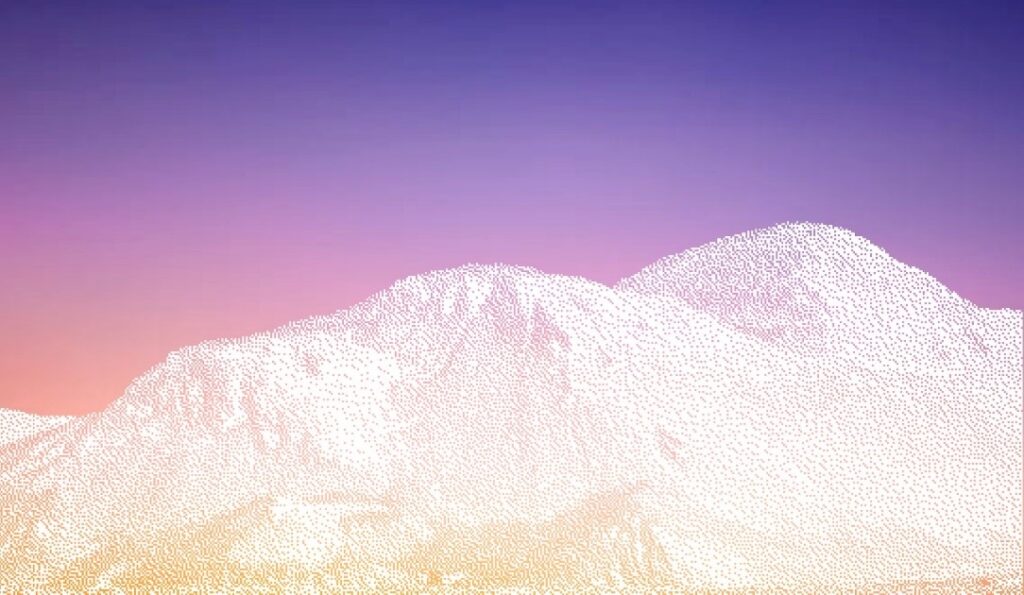
Lea Bucknell
Ecstasy of Beige, (Sunset Edition), 2022
Serigraph print
Lea Bucknell
This print revisits a sequenced light installation created for Luminosity – a biannual art exhibition hosted by the Kamloops Art Gallery in public spaces throughout downtown Kamloops. The original artwork, Ecstasy of Beige, was a large-scale, heavily pixelated image of Mount Peter and Mount Paul in Kamloops printed in light brown to emulate the semi-arid hills. The image was activated by light equipment commonly associated with parties and concert light shows to simulate the colours of sunrise and sunset. The ever-changing sequence of vibrant colours on the beige landscape created a humourous and playful interpretation of an extended sunrise and sunset. The print, Sunset Edition, utilizes the same heavily pixelated landscape to recreate the magic of sunsets on the beige desert hills.
Lea Bucknell is a Kamloops-based artist and educator who works as a studio technician and instructor in the Visual Arts program at Thompson Rivers University. She obtained her Master of Fine Arts degree from Western University, London, Ontario, and has participated in residencies at the Banff Centre for Arts and Creativity, Banff, Alberta; the Vermont Studio Center, Johnson, Vermont; and the Klondike Institute of Art and Culture, Dawson City, Yukon. Bucknell has received grants from the BC Arts Council and Canada Council for the Arts, as well as several other scholarships and awards.
Thank you for taking the time to view the RIH Foundation art collection. We would like to take this opportunity to acknowledge the support of the staff from the Kamloops Art Gallery – this would not be possible without their knowledge and expertise. We are grateful to each and every artist for their contribution to build a visually captivating and therapeutic healthcare environment for all to enjoy. To the staff, patients, and families viewing the art throughout the Phil and Jennie Gaglardi Tower, we hope this lifts your spirit during your time at Royal Inland Hospital.
